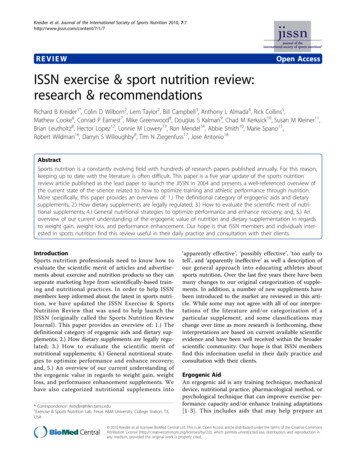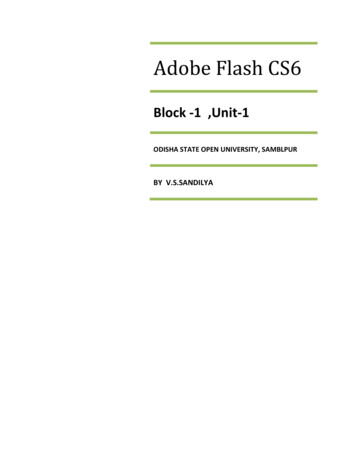
Transcription
Helms et al. Journal of the International Society of Sports Nutrition 2014, n AccessEvidence-based recommendations for naturalbodybuilding contest preparation: nutrition andsupplementationEric R Helms1*, Alan A Aragon2 and Peter J Fitschen3AbstractThe popularity of natural bodybuilding is increasing; however, evidence-based recommendations for it are lacking.This paper reviewed the scientific literature relevant to competition preparation on nutrition and supplementation,resulting in the following recommendations. Caloric intake should be set at a level that results in bodyweightlosses of approximately 0.5 to 1%/wk to maximize muscle retention. Within this caloric intake, most but not allbodybuilders will respond best to consuming 2.3-3.1 g/kg of lean body mass per day of protein, 15-30% of caloriesfrom fat, and the reminder of calories from carbohydrate. Eating three to six meals per day with a meal containing0.4-0.5 g/kg bodyweight of protein prior and subsequent to resistance training likely maximizes any theoreticalbenefits of nutrient timing and frequency. However, alterations in nutrient timing and frequency appear to havelittle effect on fat loss or lean mass retention. Among popular supplements, creatine monohydrate, caffeine andbeta-alanine appear to have beneficial effects relevant to contest preparation, however others do not or warrantfurther study. The practice of dehydration and electrolyte manipulation in the final days and hours prior tocompetition can be dangerous, and may not improve appearance. Increasing carbohydrate intake at the end ofpreparation has a theoretical rationale to improve appearance, however it is understudied. Thus, if carbohydrateloading is pursued it should be practiced prior to competition and its benefit assessed individually. Finally,competitors should be aware of the increased risk of developing eating and body image disorders in aestheticsport and therefore should have access to the appropriate mental health professionals.Keywords: Hypertrophy, Calories, Frequency, Nutrient, Body fat, Resistance training, CompetitionIntroductionThe popularity of natural bodybuilding is increasing rapidly. In the United States, over 200 amateur natural(drug tested) bodybuilding contests occurred during2013 and the number of contests is expected to increasein 2014 [1]. Preparation for bodybuilding competitioninvolves drastic reductions in body fat while maintainingmuscle mass. This is typically achieved through a decreased caloric intake, intense strength training, and increased cardiovascular exercise. Competitors partake innumerous dietary and supplementation strategies to prepare for a contest. Some have a strong scientific basis;* Correspondence: eric.helms@aut.ac.nz1Sport Performance Research in New Zealand (SPRINZ) at AUT MillenniumInstitute, AUT University, 17 Antares Place, Mairangi Bay, Auckland 0632,New ZealandFull list of author information is available at the end of the articlehowever, many do not. Therefore, the purpose of thisarticle is to review the scientific literature on topics relevant to nutrition and supplementation for bodybuildingcompetition preparation. Dietary modifications duringthe last week to enhance muscle definition and fullness(peaking) and psychosocial issues will also be covered.Ultimately, evidence-based recommendations will bemade for nutrition, supplementation, and “peak week”strategies for natural bodybuilders. As a final note, thispaper does not cover training recommendations for natural bodybuilding and the training methodology usedwill interact with and modify the effects of any nutritional approach.MethodsPubMed, MEDLINE, SPORTDiscus and CINAHL electronic databases were searched online. Each author was 2014 Helms et al.; licensee BioMed Central Ltd. This is an Open Access article distributed under the terms of the CreativeCommons Attribution License (http://creativecommons.org/licenses/by/2.0), which permits unrestricted use, distribution, andreproduction in any medium, provided the original work is properly credited.
Helms et al. Journal of the International Society of Sports Nutrition 2014, 11:20http://www.jissn.com/content/11/1/20assigned a portion of the manuscript to write specific totheir area(s) of expertise. Authors performed searchesfor key words associated with their portion(s) of themanuscript; calories and macronutrients, nutrient timingand meal frequency, dietary supplementation, psychosocial issues and “peak week” were the selected topics.The publications obtained were carefully screened forstudies that included healthy humans or humans in acaloric deficit. Long-term human studies focusing onhypertrophy and body fat loss were preferentially selected; however, acute studies and/or studies using animal models were selected in the absence of adequatelong-term human studies. In addition, author names andreference lists were used for further search of the selected papers for related references. As this review isintended to be an evidence-based guide and the availabledata relevant to natural bodybuilding is extremely limited, a narrative review style was chosen.NutritionCalories and macronutrientsCompetitive bodybuilders traditionally follow two tofour month diets in which calories are decreased and energy expenditure is increased to become as lean as possible [2-6]. In addition to fat loss, muscle maintenance isof primary concern during this period. To this end, optimal caloric intakes, deficits and macronutrient combinations should be followed while matching the changingneeds that occur during competition preparation.Caloric intake for competitionTo create weight loss, more energy must be expendedthan consumed. This can be accomplished by increasingcaloric expenditure while reducing caloric intake. Thesize of this caloric deficit and the length of time it ismaintained will determine how much weight is lost.Every pound of pure body fat that is metabolized yieldsapproximately 3500 kcals, thus a daily caloric deficit of500 kcals theoretically results in fat loss of approximately one pound per week if the weight loss comes entirely from body fat [7]. However, a static mathematicalmodel does not represent the dynamic physiological adaptations that occur in response to an imposed energydeficit [8]. Metabolic adaptation to dieting has beenstudied in overweight populations and when observed,reductions in energy expenditure amount to as little as79 kcal/d [9], to as much as 504 kcal/d beyond what ispredicted from weight loss [10]. Metabolic adaptationsto bodybuilding contest preparation have not been studied however; non-overweight men who consumed 50%of their maintenance caloric intake for 24 weeks and lostone fourth of their body mass experienced a 40% reduction in their baseline energy expenditure. Of that 40%reduction 25% was due to weight loss, while metabolicPage 2 of 20adaptation accounted for the remaining 15% [11]. Therefore, it should be expected that the caloric intake atwhich one begins their preparation will likely need to beadjusted over time as body mass decreases and metabolic adaptation occurs. A complete review of metabolicadaptation to dieting in athletes is beyond the scope ofthis review. However, coaches and competitors are encouraged to read the recent review on this topic byTrexler et al. [12] which covers not only the physiologyof metabolic adaptation, but also potential methods tomitigate its negative effects.In determining an appropriate caloric intake, it shouldbe noted that the tissue lost during the course of an energy deficit is influenced by the size of the energy deficit.While greater deficits yield faster weight loss, the percentage of weight loss coming from lean body mass(LBM) tends to increase as the size of the deficit increases [7,13-15]. In studies of weight loss rates, weeklylosses of 1 kg compared to 0.5 kg over 4 weeks resultedin a 5% decrease in bench press strength and a 30%greater reduction in testosterone levels in strength training women [16]. Weekly weight loss rates of 1.4% ofbodyweight compared to 0.7% in athletes during caloricrestriction lasting four to eleven weeks resulted in reductions of fat mass of 21% in the faster weight lossgroup and 31% in the slower loss group. In addition,LBM increased on average by 2.1% in the slower lossgroup while remaining unchanged in the faster lossgroup. Worthy of note, small amounts of LBM were lostamong leaner subjects in the faster loss group [13].Therefore, weight loss rates that are more gradual maybe superior for LBM retention. At a loss rate of 0.5 kg perweek (assuming a majority of weight lost is fat mass), a70 kg athlete at 13% body fat would need to be no morethan 6 kg to 7 kg over their contest weight in order toachieve the lowest body fat percentages recorded in competitive bodybuilders following a traditional three monthpreparation [4,6,17-20]. If a competitor is not this lean atthe start of the preparation, faster weight loss will be required which may carry a greater risk for LBM loss.In a study of bodybuilders during the twelve weeks before competition, male competitors reduced their caloricintake significantly during the latter half and subsequently lost the greatest amount of LBM in the finalthree weeks [21]. Therefore, diets longer than two tofour months yielding weight loss of approximately 0.5 to1% of bodyweight weekly may be superior for LBM retention compared to shorter or more aggressive diets.Ample time should be allotted to lose body fat to avoid anaggressive deficit and the length of preparation should betailored to the competitor; those leaner dieting for shorterperiods than those with higher body fat percentages. Itmust also be taken into consideration that the leaner thecompetitor becomes the greater the risk for LBM loss
Helms et al. Journal of the International Society of Sports Nutrition 2014, 11:20http://www.jissn.com/content/11/1/20[14,15]. As the availability of adipose tissue declines thelikelihood of muscle loss increases, thus it may be best topursue a more gradual approach to weight loss towardsthe end of the preparation diet compared to the beginningto avoid LBM loss.Determining macronutrient intakeProtein Adequate protein consumption during contestpreparation is required to support maintenance of LBM.Athletes require higher protein intakes to support increased activity and strength athletes benefit from higherintakes to support growth of LBM [5,22-28]. Some researchers suggest these requirements increase furtherwhen athletes undergo energy restriction [13,16,22,28-33].Furthermore, there is evidence that protein requirementsare higher for leaner individuals in comparison to thosewith higher body fat percentages [7,33,34].The collective agreement among reviewers is that a protein intake of 1.2-2.2 g/kg is sufficient to allow adaptationto training for athletes whom are at or above their energyneeds [23-28,35-38]. However, bodybuilders during theircontest preparation period typically perform resistance andcardiovascular training, restrict calories and achieve verylean conditions [2-6,17-21]. Each of these factors increasesprotein requirements and when compounded may furtherincrease protein needs [33]. Therefore, optimal protein intakes for bodybuilders during contest preparation may besignificantly higher than existing recommendations.In support of this notion, Butterfield et al. [22] foundthat male athletes running five to 10 miles per day during a slight caloric deficit were in a significant negativenitrogen balance despite consuming 2 g/kg of proteindaily. Celejowa et al. [39] showed that five out of 10competitive weight lifters achieved a negative nitrogenbalance over the course of a training camp while consuming an average protein intake of 2 g/kg. Out of thesefive, as many as three were in a caloric deficit. The authors concluded that a protein intake of 2–2.2 g/kgunder these conditions only allows for a small margin oferror before nitrogen losses occur.Walberg et al. [32] examined the effects of two energyrestricted isocaloric diets of differing protein intakes in19 lean (9.1-16.7% body fat), male, non-competitivebody builders. One group consumed a protein intake of0.8 g/kg and higher carbohydrates, while the other consumed 1.6 g/kg of protein with lower carbohydrates. Thelength of the intervention was only one week, but nonetheless nitrogen losses occurred only in the lower protein group and LBM decreased by a mean of 2.7 kg inthe 0.8 g/kg protein group and by a mean of 1.4 kg inthe 1.6 g/kg protein group. While the high protein groupmitigated LBM losses compared to the low proteingroup, they were not eliminated.Page 3 of 20A recent study by Mettler et al. [29] employed the samebasic methodology as Walberg et al. [32]. However, onegroup consumed a protein intake of 1 g/kg, while theother consumed 2.3 g/kg. The high-protein group lost significantly less LBM (0.3 kg) over the course of the twoweek intervention compared to the low-protein group(1.6 kg). Unlike Walberg et al. [32] calorie balance between diets was maintained by reducing dietary fat as opposed to carbohydrate to allow for the increase in protein.While it appears that the 2.3 g/kg protein interventionin Mettler et al. [29] was superior for maintaining LBMcompared to 1.6 g/kg in Walberg et al. [32] a recentstudy by Pasiakos et al. [40] found a trend towards theopposite. In this study, a non-significant trend of greaterLBM retention occurred when subjects consumed 1.6g/kg of protein compared to 2.4 g/kg of protein. However, the participants were intentionally prescribed lowvolume, low intensity resistance training "to minimizethe potential of an unaccustomed, anabolic stimulusinfluencing study outcome measures". Thus, the nonanabolic nature of the training may not have increasedthe participants’ protein requirements to the same degree as the participants in Mettler et al. [29] or to whatwould be expected among competitive bodybuilders.Maestu et al. [6] did not observe a significant loss ofLBM in a group of drug free bodybuilders consuming2.5-2.6 g/kg of protein during the 11 weeks prior tocompetition. These results when considered alongsidethe works by Walberg et al. [32] and Mettler et al. [29]imply that the higher the protein intake, the lower thechance for LBM loss. However, it should be noted thatthis study did not include a low protein control and notall studies show a linear increase in LBM preservationwith increases in protein [40]. Furthermore, two subjectsdid lose significant amounts of LBM (1.5 kg and 1.8 kg),and the authors noted that these specific bodybuilderswere among the leanest of the subjects. These two subjects lost the majority of their LBM (approximately 1 kg)during the latter half of the intervention as their percentage of calories from protein increased from 28% to32-33% by the end of the study. The group as a wholeprogressively decreased their calories by reducing allthree macronutrients throughout the investigation.Thus, the two subjects uniquely increased their proportion of protein, possibly reducing fat and carbohydrateto the point of detriment [6]. That said it is also plausible that the lost LBM seen by these two subjects wasnecessary in order to achieve their low levels of body fat.It is unknown whether or not the lost LBM influencedtheir competitive outcome and it is possible that had thecompetitors not been as lean, they may have retainedmore LBM but also not have placed as well.In a review by Phillips and Van Loon [28], it is suggested that a protein intake of 1.8-2.7 g/kg for athletes
Helms et al. Journal of the International Society of Sports Nutrition 2014, 11:20http://www.jissn.com/content/11/1/20training in hypocaloric conditions may be optimal.While this is one of the only recommendations existingthat targets athletes during caloric restriction, this recommendation is not given with consideration to bodybuilders performing concurrent endurance and resistancetraining at very low levels of body fat. However, the recently published systematic review by Helms et al. [33] onprotein intakes in resistance-trained, lean athletes duringcaloric restriction suggests a range of 2.3-3.1 g/kg of LBM,which may be more appropriate for bodybuilding. Moreover, the authors suggest that the lower the body fat of theindividual, the greater the imposed caloric deficit andwhen the primary goal is to retain LBM, the higher theprotein intake (within the range of 2.3-3.1 g/kg of LBM)should be.Carbohydrate High carbohydrate diets are typicallythought to be the athletic performance standard. However, like protein, carbohydrate intake needs to be customized to the individual. Inadequate carbohydrate canimpair strength training [41] and consuming adequatecarbohydrate prior to training can reduce glycogen depletion [42] and may therefore enhance performance.While it is true that resistance training utilizes glycogen as its main fuel source [43], total caloric expenditureof strength athletes is less than that of mixed sport andendurance athletes. Thus, authors of a recent review recommend that carbohydrate intakes for strength sports,including bodybuilding, be between 4–7 g/kg dependingon the phase of training [26]. However, in the specificcase of a bodybuilder in contest preparation, achievingthe necessary caloric deficit while consuming adequateprotein and fat would likely not allow consumption atthe higher end of this recommendation.Satiety and fat loss generally improve with lower carbohydrate diets; specifically with higher protein to carbohydrate ratios [44-49]. In terms of performance and health,low carbohydrate diets are not necessarily as detrimentalas typically espoused [50]. In a recent review, it was recommended for strength athletes training in a caloricallyrestricted state to reduce carbohydrate content while increasing protein to maximize fat oxidation and preserveLBM [28]. However, the optimal reduction of carbohydrate and point at which carbohydrate reduction becomesdetrimental likely needs to be determined individually.One comparison of two isocaloric, energy restricteddiets in bodybuilders showed that a diet that providedadequate carbohydrate at the expense of protein (1 g/kg)resulted in greater LBM losses compared to a diet thatincreased protein (1.6 g/kg) through a reduction ofcarbohydrate [32]. However, muscular endurance wasdegraded in the lower carbohydrate group. In a study ofathletes taking in the same amount of protein (1.6 g/kg)during weight loss, performance decrements and LBMPage 4 of 20losses were avoided when adequate carbohydrate wasmaintained and dietary fat was lowered [13]. Mettler,et al. [29] also found that a caloric reduction comingfrom dietary fat while maintaining adequate carbohydrate intake and increasing protein to 2.3 g/kg maintained performance and almost completely eliminatedLBM losses in resistance trained subjects. Finally, inPasiakos et al. [40] participants undergoing an equal calorie deficit and consuming the same amount of proteinas those observed in Mettler et al. [29] lost three timesthe amount of LBM over the same time period (0.9 kg inthe first two weeks of energy restriction observed byPasiakos versus 0.3 kg observed by Mettler). One keydifference between these studies was the highest proteingroup in Mettler et al. [29] consumed a 51% carbohydrate diet while the comparable group in Pasiakos et al.[40] consumed a 27% carbohydrate diet. While performance was not measured, the participants in Pasiakoset al. [40] performing sets exclusively of 15 repetitionsvery likely would have experienced decrements in performance due to this carbohydrate intake level [32]. Thedifference in training protocols or a nutritionally mediated decrement in training performance could haveeither or both been components that lead to the greaterlosses of LBM observed by Pasiakos et al. [40].While it appears low carbohydrate, high protein dietscan be effective for weight loss, a practical carbohydratethreshold appears to exist where further reductionsnegatively impact performance and put one at risk forLBM losses. In support of this notion, researchers studying bodybuilders during the final 11 weeks of contestpreparation concluded that had they increased carbohydrate during the final weeks of their diet they may havemitigated metabolic and hormonal adaptations that wereassociated with reductions in LBM [6].Therefore, once a competitor has reached or hasnearly reached the desired level of leanness, it may be aviable strategy to reduce the caloric deficit by an increase in carbohydrate. For example, if a competitor hasreached competition body fat levels (lacking any visiblesubcutaneous fat) and is losing half a kilogram per week(approximately a 500 kcals caloric deficit), carbohydratecould be increased by 25-50 g, thereby reducing the caloric deficit by 100-200 kcals in an effort to maintain performance and LBM. However, it should be noted thatlike losses of LBM, decrements in performance may notaffect the competitive outcome for a bodybuilder. It ispossible that competitors who reach the leanest condition may experience unavoidable drops in performance.Fat The importance of carbohydrate and protein in sportsnutrition is often emphasized over that of dietary fat. Subsequently, recommendations typically focus on maintaining adequate fat intake while emphasizing carbohydrate to
Helms et al. Journal of the International Society of Sports Nutrition 2014, 11:20http://www.jissn.com/content/11/1/20fuel performance and protein to build and repair LBM.However, there is evidence that dietary fat influences anabolic hormone concentrations which may be of interestto bodybuilders attempting to maintain LBM while dieting [5,26,51,52].Reductions in the percentage of dietary fat in isocaloric diets from approximately 40% to 20% has resulted inmodest, but significant, reductions in testosterone levels[53,54]. However, distinguishing the effects of reducingtotal dietary fat on hormonal levels from changes in caloric intake and percentages of saturated and unsaturatedfatty acids in the diet is difficult [51,52,55]. In a study byVolek et al. [51], correlations were found between testosterone levels, macronutrient ratios, types of lipids, andtotal dietary fat, illustrating a complex interaction of variables. In a similar study of resistance trained males, correlations were found between testosterone, protein, fatand saturated fat which lead the researchers to concludethat diets too low in fat or too high in protein might impair the hormonal response to training [52].Competing bodybuilders must make an obligatory caloric reduction. If a reduction in fat is utilized, it may bepossible to attenuate a drop in testosterone by maintaining adequate consumption of saturated fat [5]. However, adrop in testosterone does not equate to a reduction inLBM. In direct studies of resistance trained athletesundergoing calorically restricted high protein diets, low fatinterventions that maintain carbohydrate levels [13,29] appear to be more effective at preventing LBM loses thanlower carbohydrate, higher fat approaches [32,40]. Theseresults might indicate that attempting to maintain resistance training performance with higher carbohydrate intakes is more effective for LBM retention than attemptingto maintain testosterone levels with higher fat intakes.Body composition and caloric restriction may playgreater roles in influencing testosterone levels that fatintake. During starvation, a reduction in testosterone occurs in normal weight, but not obese, males [56]. Inaddition, rate of weight loss may influence testosteronelevels. Weekly target weight loss rates of 1 kg resulted ina 30% reduction in testosterone compared to targetweight loss rates of 0.5 kg per week in resistance trainedwomen of normal weight [16]. Additionally, an initialdrop in testosterone occurred in the first six weeks ofcontest preparation in a group of drug free bodybuildersdespite various macronutrient percentages [6]. Finally, ina one year case study of a natural competitive bodybuilder, testosterone levels fell to one fourth their baseline values three months into the six month preparationperiod. Levels then fully recovered three months intothe six month recovery period. Testosterone did not decline further after the initial drop at the three monthmark despite a slight decrease in fat intake from 27% to25% of calories at the six month mark. Furthermore, thePage 5 of 20quadrupling of testosterone during the recovery periodfrom its suppressed state back to baseline was accompanied by a 10 kg increase in body mass and a 1000 kcalincrease in caloric intake. However, there was only aminor increase in calories from fat (percentage of calories from fat during recovery was between (30 and 35%)[57]. Finally, these testosterone changes in men appearmostly related to energy availability (body fat contentand energy balance), and not surprisingly low-levels ofsustained energy availability are also the proposed causeof the hormonal disturbance “athletic amenorrhea” inwomen [58]. Thus, the collective data indicates thatwhen extremely lean body compositions are attainedthrough extended, relatively aggressive dieting, the caloric deficit and loss of body fat itself may have a greaterimpact on testosterone than the percentage of caloriescoming from dietary fat.While cogent arguments for fat intakes between 20 to30% of calories have been made to optimize testosteronelevels in strength athletes [59], in some cases this intakemay be unrealistic in the context of caloric restrictionwithout compromising sufficient protein or carbohydrateintakes. While dieting, low carbohydrate diets may degrade performance [32] and lead to lowered insulin andIGF-1 which appear to be more closely correlated toLBM preservation than testosterone [6]. Thus, a lowerend fat intake between 15-20% of calories, which hasbeen previously recommended for bodybuilders [5], canbe deemed appropriate if higher percentages would reduce carbohydrate or protein below ideal ranges.Ketogenic diets and individual variabilitySome bodybuilders do use very-low carbohydrate, "ketogenic diets" for contest preparation [60,61]. While thesediets have not been sufficiently studied in bodybuilders,some study of ketogenic diets has occurred in resistancetrained populations. In an examination of the effects of a1 week ketogenic diet (5.4% of calories from carbohydrate) in subjects with at least 2 years of resistance training experience, Sawyer et al. [62] observed slightdecreases in body fat among female participants andmaintenance or slight increases in measures of strengthand power among both male and female participants.However, it is difficult to draw conclusions due to thevery short term nature of this study and due to an adlibitum implementation of the ketogenic diet. As implemented in this study, besides a reduction in carbohydrate and an increase in dietary fat, the ketogenic dietresulted in an average reduction of 381 calories per dayand an increase of 56 g of protein per day compared tothe participants’ habitual diets. Thus, it is unclearwhether the improvements in body composition andperformance can be attributed to the low-carbohydrateand high-fat nature of the diets or rather a decrease in
Helms et al. Journal of the International Society of Sports Nutrition 2014, 11:20http://www.jissn.com/content/11/1/20calories and an increase in protein. At least with regardsto weight loss, previous research indicates that the oftenconcomitant increase in protein observed in very lowcarbohydrate diets may actually be the key to their success [63].The only research on strength athletes following ketogenic diets for longer periods is a study of gymnasts inwhich they were observed to maintain strength performance and lose more body fat after 30 days on a ketogenicdiet in comparison to 30 days on a traditional westerndiet [64]. However, this study's sample size was limited(n 8) and it was not a controlled study of an intentionalfat-loss phase such as seen among bodybuilders duringcompetition preparation. Therefore, more study is neededin resistance trained populations and bodybuilders beforedefinitive recommendations can be made to support ketogenic diets.However, the research that does exist challenges traditional views on carbohydrate and anaerobic performance. Despite the common belief that carbohydrate isthe sole fuel source for weight training, intramusculartriglyceride is used during short term heavy resistancetraining [65] and likely becomes an increasingly viable fuelsource for those adapted to high-fat low-carbohydrate diets. While some might suggest that this implies a ketogenic diet could be a viable option for contest preparation,a trend of decreased performance and impaired maintenance of FFM is associated with lower carbohydrate intakesin the majority of studies included in this review.While it is our contention that the majority of the evidence indicates that very-low carbohydrate diets shouldbe avoided for contest preparation (at least until more research is performed), it must be noted that there is a highdegree of variability in the way that individuals respond todiets. Carbohydrate and fat utilization as a percentage ofenergy expenditure at rest and various intensities has asmuch as a four-fold difference between individual athletes;which is influenced by muscle fiber-composition, diet, age,training, glycogen levels and genetics [66]. Additionally,individuals that are more insulin sensitive may lose moreweight with higher-carbohydrate low-fat diets while thosemore insulin resistant may lose more weight with lowercarbohydrate higher-fat diets [67].Due to this individual variability, some popular commercial bodybuilding literature suggests that somatotype and/or body fat distribution should be individuallyassessed as a way of determining macronutrient ratios.However, there is no ev
ductions of fat mass of 21% in the faster weight loss group and 31% in the slower loss group. In addition, LBM increased on average by 2.1% in the slower loss group while remaining unchanged in the faster loss group. Worthy of note, small amounts of LBM were lost among leaner







![project2 Encase.pptx [Read-Only]](/img/12/project2-encase.jpg)



